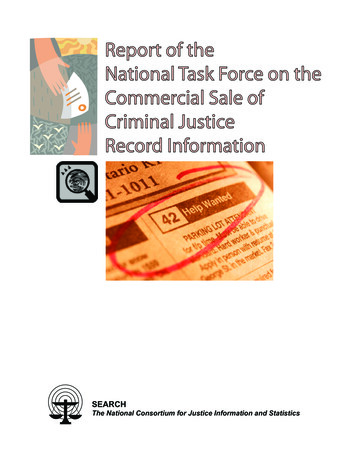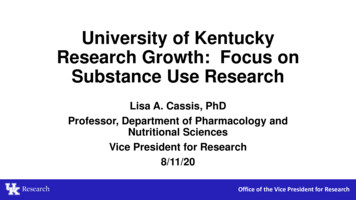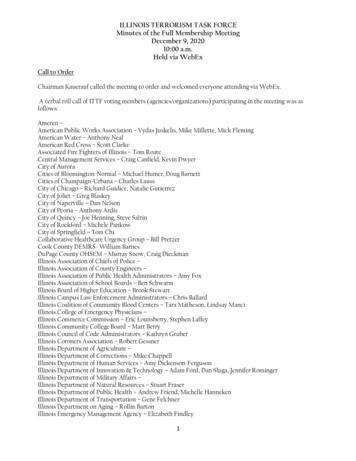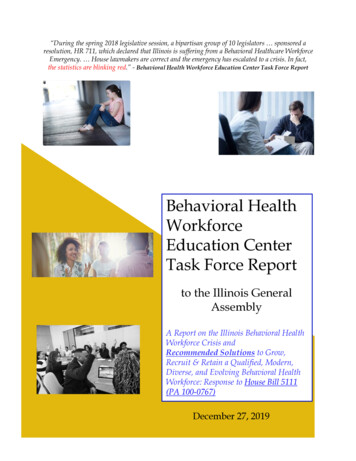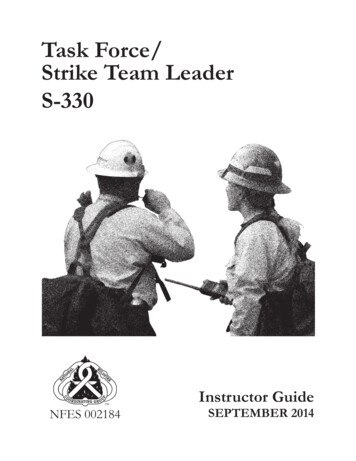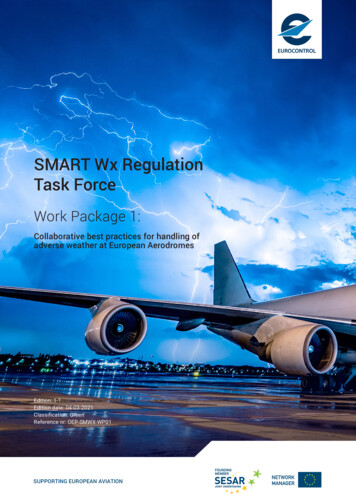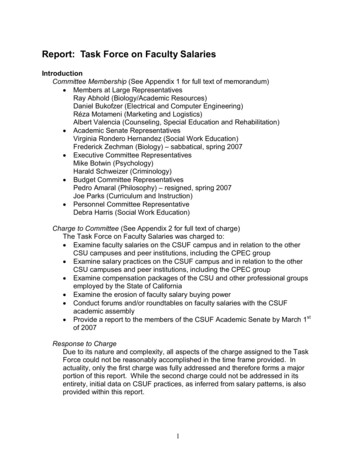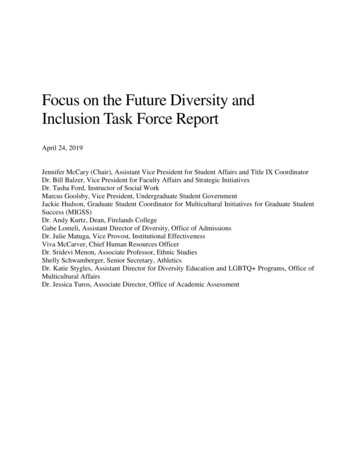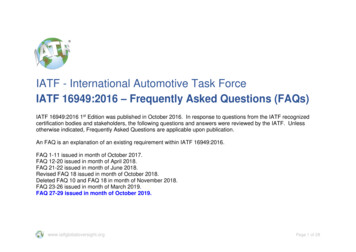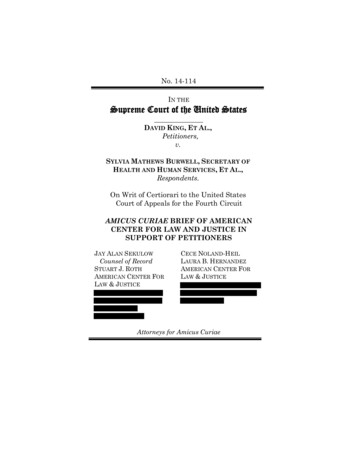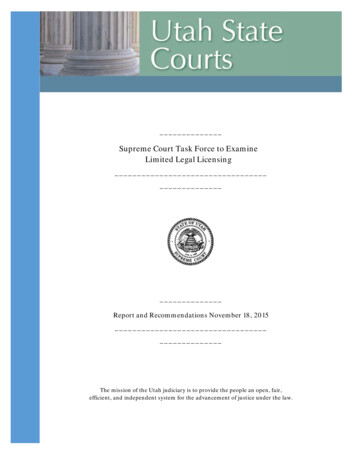
Transcription
Supreme Court Task Force to ExamineLimited Legal LicensingReport and Recommendations November 18, 2015The mission of the Utah judiciary is to provide the people an open, fair,efficient, and independent system for the advancement of justice under the law.
SUPREME COURT TASK FORCE TO EXAMINE LIMITED LEGAL LICENSING(1) Introduction and summary . 5(a) Introduction . 5(b) Task force charge. 7(c)(2)Summary of recommendations . 8The practice of law in Utah . 10(a) Authority of the supreme court to govern the practice of law . 10(b) Supreme court rules . 11(3)Program design principles . 14(4)Practice areas of greatest demand . 15(5)Procedural areas of paraprofessional competence . 16(a) How do people get advice about remedies to their “civil justicesituations”? . 16(b) How do people obtain and prepare forms? . 18(c)How do people participate in mediation? .20(d) How do people participate in hearings? . 21(e)How do people live within the resolution of their legal issue? . 21(f)How do people find a lawyer? . 21(6)Challenges to establishing a paraprofessional program. 22(7)Program evaluation . 26(a) Appropriateness . 26(b) Effectiveness . 26(c)Sustainability . 27(d) Measurements . 27(8)Characteristics of limited-licensing in other states . 28(9)Paraprofessionals in Utah . 28(a) Current Utah authority . 28(b) Other state models . 29(10)Recommendations.30(a) Recommended title .30-2-
(b) Recommended practice areas .30(c)Recommended authority. 31(i) Intake, client counseling and lawyer referral . 31(ii)Forms . 32(iii)Interaction with another party . 33(iv)Post-litigation role . 33(v)Services as a paralegal . 34(vi)Future experience . 34(d) Recommended education. 34(e)Recommended licensing and other regulations . 35(i) Administration . 35(ii)Minimum requirements . 36(iii)Legal relationship with client . 37(11)Other strategies . 37(a) Discrete legal services . 37(b) Online lawyer directory . 38(c)Online dispute resolution.40(d) Assisted resolution of cases involving self-represented parties 40(e)(12)Self-Help Center . 42Implementation. 42(a) Steering committee . 42(b) Questions for consideration . 43(13)Task force members and staff . 45(14)Draft rules. 46(15)Characteristics of limited-licensing in other states . 50(a) Arizona . 50(b) California . 51(c)Colorado . 52(d) Florida . 53(e)Louisiana . 53-3-
(f)Nevada . 54(g) Oregon . 55(h)Washington . 57(i)Other states . 58-4-
(1)INTRODUCTION AND SUMMARY(a)INTRODUCTIONProbably most Utah communities are not that different from “MiddleCity, USA,” a mid-size, mid-West community that was the location of the2014 Community Needs and Services Study by the American BarAssociation. 1 In a random sampling of adults in Middle City, 66% of therespondents had experienced an average of 3.3 “civil justice situations” 2 inthe previous 18 months, almost half of which resulted in “a significantnegative consequence.” Yet respondents identified only 9% of the situationsas “legal” and another 4% as “criminal.” In other words, many may not haverecognized recourse to the courts as an option.About 16% of the people facing a civil justice situation did nothing; 46%relied on self-help; and 23% relied on the help of family or friends. Only22% used the assistance of a lawyer or other professional. Somewhatsurprisingly, 21% of the situations were described as “properly dealt withwithin the family or community.” In other words, to a substantial minority,using an outside third party to seek a legal remedy seemed inappropriate.Forty-six percent relied on self-help. That is, as well as we can estimate,about the percentage of self-represented parties in select types of litigationin the Utah district court, and the imbalance of self-representation betweenpetitioners and respondents is even more stark. Probably the othercircumstances, opinions and responses of the residents of Middle Cityrepresent those of Utah residents as well.The cost of legal services is often cited as a major reason that people withneed of legal services do not employ lawyers, 3 yet in the Community NeedsAccessing Justice in the Contemporary USA: Findings from theCommunity Needs and Services Study. Rebecca L. Sandefur, American BarAssociation, University of Illinois at Urbana-Champaign, act id 2478040;http://perma.cc/3K7P-UPD2).1Employment, rental housing, owned housing, money, debt,insurance, government benefits, education, relationship breakdown,personal injury, criminal negligence.2See, for example, Robert Ambrogi, Washington State moves aroundUPL, using legal technicians to help close the justice gap, ABA JOURNAL(Jan. 1, 2015, 5:50 shington state moves3-5-
and Services Study “concerns about cost were a factor in 17% of cases,” eventhough 58% of respondents agreed with the statement that “lawyers are notaffordable for people on low incomes.” 4 The cost of legal services cannot beignored as a factor in the number of self-represented parties, but a commonperception is that an increasing number of people choose to representthemselves and seek help only as needed.Given our charge and the high concentration of self-represented partiesin select casetypes, we have focused primarily on creating a supply of nonlawyer paraprofessionals qualified to provide specified legal services inspecified practice areas. In doing so, we have been guided by the ABACommission on the Future of Legal Services draft resolution 5 urging “eachstate’s highest court, and those of each territory and tribe, to be guided bythe ABA Model Regulatory Objectives to help (1) assess the court’s existingregulatory framework and (2) identify and implement regulatoryinnovations related to legal services beyond the traditional regulation of thelegal profession” The commission’s regulatory objectives are: Protection of the publicAdvancement of the administration of justice and the rule of lawAccess to information about, and advancement of the public’sunderstanding of, the law, legal issues, and the civil and criminaljustice systemsTransparency regarding the nature and scope of legal services to beprovided, the credentials of those who provide them, and theavailability of regulatory protectionsDelivery of affordable and accessible legal servicesEfficient, competent, and ethical delivery of legal servicesProtection of confidential informationaround upl using legal technicians to help close the;http://perma.cc/FL75-QKAR): “[M]ultiple state and federal studies[show] that 80 to 90 percent of low- and moderate-income Americanswith legal problems are unable to obtain or afford legal representation.The economics of traditional law practice make it impossible for lawyers tooffer their services at prices these people can afford.”4Community Needs and Services Study, Id. at pages 3, 13 and ages/office president/draft regulatory objectives.pdf; http://perma.cc/2HWB-9LNY).-6-
Independence of professional judgmentAccessible civil remedies for breach of duties owed and disciplinarysanctions for incompetence, misconduct, and negligenceDiversity and inclusion among legal services providers and freedomfrom discrimination in the delivery of legal services and in the justicesystemWe have also included five other strategies to meet the needs of selfrepresented parties for assistance with their civil justice situations and toimprove access for everyone.We recognize the value of a lawyer representing a client in litigation, oradvising a client about options, or counseling a client on a course of action.We recognize the valuable services that lawyers provide to their clients everyday, in and out of court. But the data show that, even after years of effortwith pro bono and low bono programs, a large number of people do not havea lawyer to help them. The data also show that the demand is focused on theareas where the law intersects everyday life, creating a “civil justicesituation.” The people facing these situations need correct information andadvice. They need assistance. Our purpose is to consider and recommendwhether there is an alternative source for that assistance.Given the time available to us and the need for policy decisions beforebeginning the arduous work of implementation, this report remains aplanning blueprint. If our recommendations are approved, we recommendthat the supreme court appoint a steering committee to guide the next steps.(b)TASK FORCE CHARGEIn May, 2015, the supreme court created this task force to: examine emerging strategies and programs that authorizeindividuals to provide specific legal assistance in areas currentlyrestricted to licensed lawyers; andrecommend whether similar programs should be established inUtah.Specifically, the court asked us to: examine the Limited Licensed Legal Technician Program in theState of Washington—as well as other, similar programs;determine the origin, purpose, content, requirements, cost,authorizing entity, administration and evaluation of theseprograms;-7-
evaluate whether the programs would materially improve accessand affordability for select types of legal assistance;evaluate the balance between increasing access and ensuringconsumer protection;evaluate where the greatest need for legal assistance exists andhow these programs might address that need; andconsider issues that would have to be addressed in theimplementation, regulation and administration of a program,such as:o role definition;o training/certification requirements;o scope of services;o regulatory authority; ando supervision/quality control/complaint process.We were ably assisted in this inquiry by Dr. Thomas Clarke, Director ofResearch and Technology for the National Center for State Courts. At ourrequest, Dr. Clarke and the National Center for State Courts prepared awhite paper with analysis and recommendations. 6 Dr. Clarke’s experienceand opinions were invaluable, and we express our sincere appreciation.Our research and materials, including this report, are on the es/limited legal/;http://perma.cc/9GCN-2J3R.(c)SUMMARY OF RECOMMENDATIONS(1) The supreme court should: Exercise its constitutional authority to govern the practice of lawto create a subset of discrete legal services that can be providedby a licensed paralegal practitioner in three practice areas:o temporary separation under Section 30-3-4.5, divorce,paternity, cohabitant abuse and civil stalking, custody andsupport, and name change;o eviction; ando debt collection.Non-Lawyer Legal Assistance Roles—Efficacy, Design, andImplementation. Thomas Clarke, Director of Research and Technology forthe National Center for State Courts.(http://www.utcourts.gov/committees/limited legal/NonLawyer%20Legal%20Assistance%20Roles.pdf; http://perma.cc/A92U-NBQJ)6-8-
Within an approved practice area, authorize a licensed paralegalpractitioner to:o establish a contractual relationship with a client who is notrepresented by a lawyer;o conduct client interviews to understand the client’sobjectives and to obtain facts relevant to achieving thatobjective;o complete court-approved forms on the client’s behalf;advise which form to use; advise how to complete theform; sign, file and complete service of the form; obtain,explain and file any necessary supporting documents; andadvise the client about the anticipated course ofproceedings by which the court will resolve the matter;o represent a client in mediated negotiations and considerwhether to authorize a licensed paralegal practitioner torepresent a client in unmediated negotiations;o prepare a written settlement agreement in conformity withthe mediated agreement; ando advise a client about how a court order affects the client’srights and obligations.Establish education requirements and regulatory requirementsto qualify as a licensed paralegal practitioner.(2) If the supreme court approves these recommendations, the courtshould appoint a steering committee to plan, design and implement theprogram details.(3) The board of bar commissioners should implement as soon aspossible the recommendations of its futures commission to build an onlinelawyer directory and for increasing the use of discrete task legal services.(4) The judicial council should: work with the committee on resources for self-representedparties to:o develop forms appropriate for approved practice areas;o improve existing forms; ando publish information about the facts and procedures relevantto the forms;establish a pilot program of assisted resolution of family lawand/or debt collection cases involving self-represented parties;continue to plan, design and build an online dispute resolutionapplication; and-9-
(2)request an appropriation to fund additional work by the self-helpcenter to instruct court staff, public library staff, community andfaith-based groups and other volunteers to enable them in turn toassist others, for free, with general legal information, opinions orrecommendations about possible legal rights, remedies, defenses,procedures, options or strategies and to assist in completingcourt-approved forms.THE PRACTICE OF LAW IN UTAH(a)AUTHORITY OF THE SUPREME COURT TO GOVERN THEPRACTICE OF LAW“The Supreme Court by rule shall govern the practice of law, includingadmission to practice law and the conduct and discipline of personsadmitted to practice law.” 7 “Admission to practice law” should retain itstraditional meaning; that is, lawyers who are licensed by the supreme courtafter meeting the minimum qualifications established by rule and theprocedures of the board of commissioners of the Utah State Bar. Elsewherein Utah law—the qualifications of a judge of a court of record, for example—the phrase is used as a term of art to mean “lawyers.”Later in this report we recommend that the supreme court exercise itsauthority to “govern” the practice of law to establish rules authorizing aparaprofessional who is not a lawyer to do some of the things traditionallyreserved for lawyers. The paraprofessional will be engaged in the practice oflaw by performing specified tasks in specified practice areas, but will not be“admitted” to practice law. 8 The limited tasks fit well within the traditionaldefinition of the practice of law, even though the paraprofessional is not alawyer. The supreme court’s exclusive authority to establish this policy isestablished in the Utah constitution and recognized by statute. Utah CodeSection 78A-9-103(1)(a) provides:Unless otherwise provided by law or court rule, an individualmay not practice law or assume to act or hold himself orherself out to the public as an individual qualified to practicelaw within this state if that individual is not admitted andlicensed to practice law within this state . (emphasis added)7Utah Constitution Art VIII, Section 4.We also recommend separate licensing, conduct, discipline, andadministrative regulations for this new paraprofessional.8- 10 -
The respective authority of the supreme court and the legislature overthe practice of law has been described as the supreme court governing theauthorized practice of law and the legislature governing the unauthorizedpractice of law. See Board of Commissioners of the Utah State Bar v.Petersen, 937 P.2d 1263, 1270 (Utah 1997). Section 78A-9-103 prohibitspracticing law without a license and provides a civil remedy for the board ofcommissioners of the Utah State Bar.(b)SUPREME COURT RULESThe practice of law is a defined term, and, with certain exceptions, onlylawyers may do it. Initially adopted in 2005 under a different system fororganizing the rules governing the practice of law, Rule 14-802 nowprovides:[O]nly persons who are active, licensed members of the Bar ingood standing may engage in the practice of law in Utah. The “practice of law” is the representation of the interests ofanother person by informing, counseling, advising, assisting,advocating for or drafting documents for that person throughapplication of the law and associated legal principles to thatperson’s facts and circumstances.Special Practice Rules. Rule 14-802(a)(2) and (b).Rule 14-802(c) then removes from the definition certain services thatpossibly satisfy the general definition, but which nevertheless are not thepractice of law. In other words, sometimes a non-lawyer with specifiedcredentials and so
Nov 18, 2015 · by a licensed paralegal practitioner in three practice areas: o temporary separation under Section 30-3-4.5, divorce, paternity, cohabitant abuse and civil stalking , custody and support, and name change; o eviction; and o debt collection. 6 Non-Lawyer Legal Assistance Roles—Efficacy, Design, and
